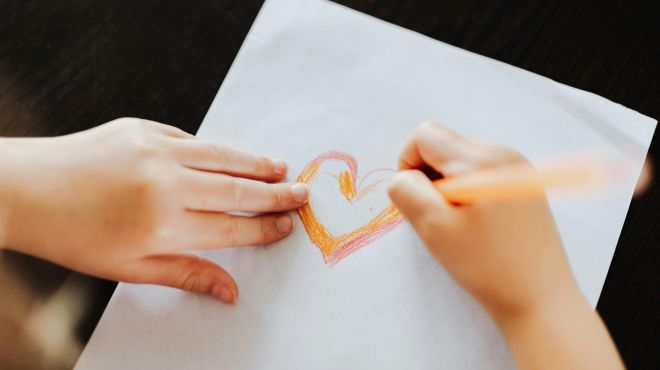Sometimes our hearts feel heavy, but words are hard to find. That’s when art therapy journaling can help. It’s a gentle, creative way to explore your thoughts and emotions through drawing, painting, and writing.
You don’t have to be an artist or a writer. All you need is a notebook, some colors, and a little quiet time for yourself.
This guide will explain what art therapy journaling is, why it helps, and how you can use simple prompts to start your own healing and creative journey.
What Is Art Therapy Journaling?
Art therapy journaling combines two things: making art and writing.
In a regular journal, you might write about your day or your feelings. In an art therapy journal, you can also draw, paint, or collage what’s on your mind.
You might fill a page with colors, shapes, or images that represent how you feel, then write a few sentences about it. It’s not about creating perfect art. It’s about expressing what’s inside in a safe and gentle way.
This practice comes from art therapy, a type of mental health support that uses creativity to help people express emotions and find healing. You can do your own version of this practice at home, using simple materials and guided prompts.
Why Art Therapy Journaling Helps
Art therapy works because it helps you process feelings in a way that words alone sometimes cannot.
When you draw or paint, you tap into the emotional part of your brain, not just the logical side. You express feelings through color, texture, and movement — and that can be deeply freeing.
Here are a few reasons why it’s so powerful:
- It helps you release emotions.
You might not always know how to talk about what you feel. Creating art lets those feelings come out in a natural, gentle way. - It brings calm and focus.
The process of drawing or painting helps your mind slow down. It’s almost like meditation — your breathing evens out, and you start to relax. - It helps you understand yourself better.
Art often reveals things we don’t consciously notice. The colors or shapes you choose can reflect emotions or patterns in your life. - It builds self-confidence.
Every time you create something, you remind yourself that your inner world matters. Your art becomes proof that your feelings have value. - It encourages play and joy.
Many adults forget how to play. Art journaling brings that sense of curiosity and fun back into your life.
What You Need to Get Started
You don’t need expensive art supplies. Here’s what’s enough to begin:
- A notebook or sketchbook (mixed media paper is ideal)
- Colored pencils, crayons, or markers
- Paints or brushes if you enjoy them
- A pen or pencil for writing
- Optional: magazines, glue, stickers, or washi tape for collaging
Choose a quiet spot, maybe play soft music, and give yourself permission to create freely.
How to Use Art Therapy Journal Prompts
Art therapy journal prompts are short ideas or questions that help you begin. They give your creativity a direction without limiting it.
Here’s how to use them:
- Pick a prompt.
Choose one that matches how you feel or what you want to explore. - Create your art.
Don’t think too much. Use colors, textures, or shapes that feel right in the moment. - Write your reflection.
After creating your art, write a few lines about it. What did you notice? How do you feel now? Did anything surprise you? - Review your pages later.
Over time, your journal becomes a visual diary of your growth. Looking back can help you see how your emotions have changed.
20 Art Therapy Journal Prompts to Try
Here are some simple and gentle prompts you can use in your own journal:
- Draw your current mood using colors and shapes.
- Create your safe place — a setting where you feel calm and at peace.
- Draw what your heart feels like today.
- Make a gratitude collage filled with images and words that make you smile.
- Paint your stress, then draw something that brings you peace.
- Illustrate a happy memory from your life.
- Create a self-portrait using symbols instead of your face.
- Draw your dreams for the future.
- Sketch your inner child and write a message to them.
- Paint your fears, then transform them with color or light.
- Use only one color to show your current state of mind.
- Draw what love feels like.
- Create a symbol that represents your personal strength.
- Draw a storm, then the calm that follows.
- Paint the way your favorite sound looks.
- Write kind words to yourself and decorate the page.
- Sketch your comfort zone — what’s inside it, and what’s just beyond it.
- Create a page about something you’re ready to let go of.
- Draw your hands and write about what they’ve done and held.
- Create a “Today I choose…” page filled with your mood and goals.
You can do one each day, once a week, or whenever you need a quiet moment to reflect.
Tips for a Meaningful Practice
- Let go of the need to make something perfect. This journal is just for you.
- Be consistent. Even a few minutes a week can make a big difference.
- Don’t judge what you create. Observe it gently and notice what it tells you.
- Engage your senses. Feel the texture of the paper, the flow of the brush, the smell of the paint.
- Make it comfortable. Treat your art time as a self-care ritual — light a candle or make tea if you like.
How You’ll Change Over Time
If you keep an art therapy journal for several weeks or months, you’ll start to see changes — not just on the pages, but within yourself.
You might notice your color choices changing. Maybe your drawings become freer, or your words kinder. These are signs of healing.
Your journal becomes a visual story of your emotional journey — a record of your growth, strength, and resilience.
Final Thoughts
Art therapy journaling isn’t about making perfect art. It’s about expressing what’s real, even when words aren’t enough.
Each page you fill is a conversation with your heart. Each color or shape holds a piece of your truth.
So take a deep breath, pick up your pen or brush, and let your feelings flow onto the page.
You’ll be surprised at how much lighter you feel afterward — and how much beauty you can create when you stop trying to be perfect and simply let yourself be.



